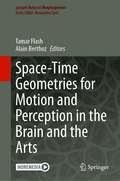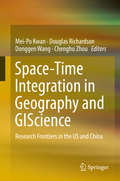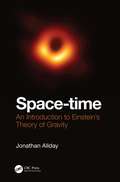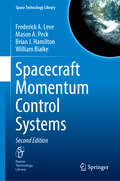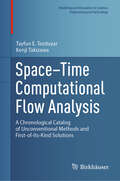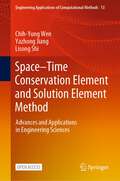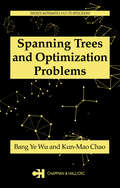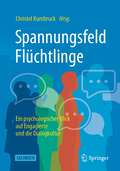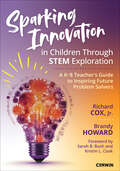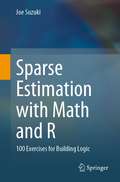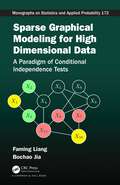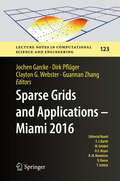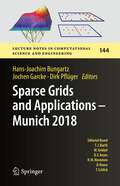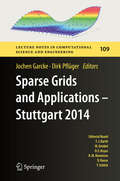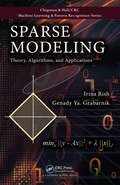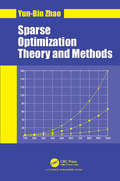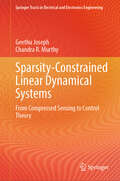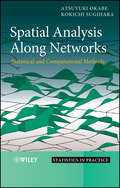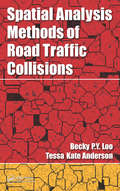- Table View
- List View
Space-Time Geometries for Motion and Perception in the Brain and the Arts (Lecture Notes in Morphogenesis)
by Alain Berthoz Tamar FlashThis book is based on a two-day symposium at the Paris Institute of Advanced Study titled "space-time geometries and movement in the brain and the arts". It includes over 20 chapters written by the leading scientists and artists who presented their related research studies at the symposium and includes six sections; the first three focus on space-time geometries in perception, action and memory while the last three focus on specific artistic domains: drawing and painting, dance, music, digital arts and robotics. The book is accompanied by a dedicated webpage including related images and videos. There is an ever-growing interest in the topics covered by this book. Space and time are of fundamental importance for our understanding of human perception, action, memory and cognition, and are entities which are equally important in physics, biology, neuroscience and psychology. Highly prominent scientists and mathematicians have expressed their belief that our bodies and minds shape the ways we perceive space and time and the physical laws we formulate. Understanding how the brain perceives motion and generates -bodily movements is of great significance. There is also growing interest in studying how space, time and movement subserve artistic creations in different artistic modalities (e.g., fine arts, digital and performing arts and music). This interest is inspired by the idea that artists make intuitive use of the principles and simplifying strategies used by the brain in movement generation and perception. Building upon new understanding of the spatio-temporal geometries subserving movement generation and perception by the brain we can start exploring how artists make use of such neuro --geometrical and neuro-dynamic representations in order to express artistic concepts and emotionally affect the human observers and listeners. Scientists have also started formulating new ideas of how aesthetic judgements emerge from the principles and brain mechanisms subserving motor control and motion perception.Covering novel and multidisciplinary topics, this advanced book will be of interest to neuroscientists, behavioral scientists, artificial intelligence and robotics experts, students and artists.
Space-Time Integration in Geography and GIScience
by Donggen Wang Chenghu Zhou Mei-Po Kwan Douglas RichardsonSpace-time analysis is a rapidly growing research frontier in geography, GIS, and GIScience. Advances in integrated GPS/GIS technologies, the availability of large datasets (over time and space), and increased capacity to manage, integrate, model and visualize complex data in (near) real time, offer the GIS and geography communities extraordinary opportunities to begin to integrate sophisticated space-time analysis and models in the study of complex environmental and social systems, from climate change to infectious disease transmission. This volume specifically focuses on research frontiers, comparative research, and research and application interactions in this field in the US and China, arguably the two most dynamic loci for this work today. The contributions to this book, by top researchers in China and the US, productively highlight the differences and similarities in approaches and directions for space-time analysis in the two countries. In light of the recent rapid progress in GIScience research on space-time integration in both countries, the book's focus on research frontiers in these two countries will attract great interest in both countries and in other parts of the world as well as among related disciplines. In addition, the book also explores the impact of collaborative research and publications underway in this area between the US and China and will provide an overview of these collaborative efforts and programs. This book will not only be of interest to university-based GIS researchers and students, but also to those interested in this new area of research and applications like researchers and developers in business, internet mapping and GIS and location based services (LBS).
Space-time: An Introduction to Einstein's Theory of Gravity
by Jonathan AlldayThis book, suitable for interested post-16 school pupils or undergraduates looking for a supplement to their course text, develops our modern view of space-time and its implications in the theories of gravity and cosmology. While aspects of this topic are inevitably abstract, the book seeks to ground thinking in observational and experimental evidence where possible. In addition, some of Einstein’s philosophical thoughts are explored and contrasted with our modern views. Written in an accessible yet rigorous style, Jonathan Allday, a highly accomplished writer, brings his trademark clarity and engagement to these fascinating subjects, which underpin so much of modern physics. Features: Restricted use of advanced mathematics, making the book suitable for post-16 students and undergraduates Contains discussions of key modern developments in quantum gravity, and the latest developments in the field, including results from the Laser Interferometer Gravitational-Wave Observatory (LIGO) Accompanied by appendices on the CRC Press website featuring detailed mathematical arguments for key derivations
Spacecraft Momentum Control Systems (Space Technology Library #46)
by Frederick A. Leve Brian J. Hamilton Mason A. Peck William BialkeWith space-industry professionals and university students, this book offers a practical technical reference for seeking to understand the state of the art in spacecraft momentum control systems. The focus is control moment gyroscope (CMG) technology, but general principles of momentum control—for example, through reaction wheels, magnetic torque actuation, and other means—are presented. These key topics are treated in several contexts: systems engineering and spacecraft architecture, attitude control and dynamics, and mission operations. The subject matter is developed with theoretical rigor and in terms of practical implementation in flight hardware software. This book is the first to address CMG technology in depth, let alone from a practitioner&’s perspective. It is also timely, given the rise of commercial Earth imaging, the imminent need for high-torque manipulation of satellites for servicing and assembly, the advances in privately built spacecraft (including small satellites), and the growing popularity of the subject matter in academia over the past two decades. The current edition includes exercises suitable for upper-level undergraduate courses and graduate-level courses in spacecraft attitude dynamics and control, spacecraft design, and space systems engineering. This second edition provides more applications, attitude control, momentum and nutation dumping, isolation, system identification, systems engineering, bearings, and structures as well as more in depth discussions of equations of motion, as well as the numerics and complexity associated with generalized inverses that are used for steering algorithms.
Space–Time Computational Flow Analysis: A Chronological Catalog of Unconventional Methods and First-of-Its-Kind Solutions (Modeling and Simulation in Science, Engineering and Technology)
by Tayfun E. Tezduyar Kenji TakizawaSpace–Time Computational Flow Analysis (STCFA) was developed in 1990 in the context of flows with moving boundaries and interfaces, which is a wide class of problems that includes fluid–particle interactions, fluid–structure interactions (FSI), and free-surface and multi-fluid flows. It is a computational framework made of unconventional methods, which have evolved over the years as more unconventional methods were introduced to increase its scope and accuracy. It brought first-of-its-kind solutions in many classes of problems, including fluid–particle interactions in particle-laden flows, FSI in parachute aerodynamics, flapping-wing aerodynamics of an actual locust, ventricle-valve-aorta flow analysis, and car and tire aerodynamics. With these successes in so many classes of problems, the STCFA has reached a level of remarkable sophistication, scope, and practical value. This monograph presents, for the first time, a chronological catalog of STCFA methods and solutions from their development to the present. Part I focuses on the STCFA in the context of finite element analysis, and Part II in the context of isogeometric analysis. The methods presented include complementary general-purpose methods that were introduced in the evolution of STCFA. All researchers working on or interested in space–time computations in fluid mechanics, FSI, and solid mechanics, including graduate students, will benefit from the wealth of powerful computational methods and impressive solutions they will find in the book.
Space–Time Conservation Element and Solution Element Method: Advances and Applications in Engineering Sciences (Engineering Applications of Computational Methods #13)
by Chih-Yung Wen Yazhong Jiang Lisong ShiThis open access book introduces the fundamentals of the space–time conservation element and solution element (CESE) method, which is a novel numerical approach for solving equations of physical conservation laws. It highlights the recent progress to establish various improved CESE schemes and its engineering applications. With attractive accuracy, efficiency, and robustness, the CESE method is particularly suitable for solving time-dependent nonlinear hyperbolic systems involving dynamical evolutions of waves and discontinuities. Therefore, it has been applied to a wide spectrum of problems, e.g., aerodynamics, aeroacoustics, magnetohydrodynamics, multi-material flows, and detonations. This book contains algorithm analysis, numerical examples, as well as demonstration codes. This book is intended for graduate students and researchers who are interested in the fields such as computational fluid dynamics (CFD), mechanical engineering, and numerical computation.
Spaghetti and Meatballs for All!: A Mathematical Story
by Debbie Tilley Marilyn BurnsKids will exercise their early math skills with this bestselling picture book--now available in Scholastic Bookshelf! Mr. and Mrs. Comfort are having a family reunion! Mr. Comfort starts cooking up his famous spaghetti and meatballs, while Mrs. Comfort carefully arranges eight tables and thirty-two chairs so that everyone will have a seat. The tables look lovely, the food is ready, and here come the guests--with their own seating plans! This delightful Marilyn Burns Brainy Day Book uses wit and humor to draw children into thinking about area and perimeter.
Spanning Trees and Optimization Problems (Discrete Mathematics and Its Applications)
by Bang Ye Wu Kun-Mao ChaoThe design of approximation algorithms for spanning tree problems has become an exciting and important area of theoretical computer science and also plays a significant role in emerging fields such as biological sequence alignments and evolutionary tree construction. While work in this field remains quite active, the time has come to collect under
Spannungsfeld Flüchtlinge: Ein psychologischer Blick auf Engagierte und die Dialogkultur
by Christel KumbruckDieses Buch analysiert wissenschaftlich fundiert und zugleich allgemeinverständlich das Engagement von Menschen, die sich für die Aufnahme von Geflüchteten oder gegen die deutsche Flüchtlingspolitik engagieren, sowie ihre Motive, Emotionen, Denk- und Argumentationsweisen. Dabei werden psychologische Mechanismen, die ursächlich für die viel diskutierte Polarisierung unserer modernen Gesellschaft sind, deutlich. Erstmalig werden die tieferen Ursachen für bestehende Dialogbarrieren aufgespürt und mit psychologischen Modellen erklärt. Dabei decken die Autor*innen neben polarisierenden Dialogprozessen auch Gemeinsamkeiten beider Seiten auf und erarbeiten daraus Ansatzpunkte für Dialogchancen und eine Depolarisierung der Kommunikation. Neben der psychologischen Betrachtung erfolgt außerdem eine Einordung der beschriebenen, empirisch ermittelten Erkenntnisse in übergeordnete soziokulturelle Prozesse und gesellschaftliche Rahmenbedingungen. Auch hieraus werden Lösungsansätze, diesmal auf der Ebene von Politik und Gesellschaft, erarbeitet. Ein Buch für alle, die mehr Einblicke in das Flüchtlingsengagement haben wollen, die sich in Politik, Beratung, Coaching, Erziehung u.ä. aktiv an der Bewahrung einer Dialogkultur beteiligen, oder zumindest die (psychologischen) Mechanismen verstehen möchten, welche eine Polarisierung der Gesellschaft fördern."Dieses klare und differenzierte Arbeitsbuch ist eine großartige Hilfe zum Selbstdenken." - Prof. Aleida Assmann"Flucht und Migration werden Deutschland weiterhin vor Herausforderungen stellen. Dieses Buch zeigt nachvollziehbar, wie Wahrnehmungs-, Denk- und Handlungsweisen zu einer destruktiven Polarisierung beitragen können, aber auch welche Möglichkeiten wir alle haben, um der Falle vergifteter Kommunikation zu entgehen: ein hilfreiches Buch, um demokratischen Zusammenhalt zu stärken." - Prof. Eva Senghaas-Knobloch
Sparking Innovation in Children Through STEM Exploration: A K-8 Teacher′s Guide to Inspiring Future Problem Solvers
by Richard Cox Brandy HowardInnovation isn′t just a goal; it′s a necessity in today′s world. Today, educators face an imperative: prepare learners for an unpredictable future. Sparking Innovation in Children Through STEM Exploration: A K-8 Teacher′s Guide to Inspiring Future Problem Solvers is here to help meet that challenge by offering the tools to transform classrooms into ecosystems of creativity, collaboration, and critical thinking. This groundbreaking book goes beyond traditional STEM education and offers a comprehensive framework that helps educators cultivate the next generation of innovative thinkers and problem-solvers. Authors Richard Cox, Jr. and Brandy Howard introduce the Innov8 Framework, a dynamic and flexible roadmap designed to foster curiosity, spark imagination, and build critical thinking within classrooms and beyond. Rooted in justice, empathy, and inquiry-based learning, this approach ensures every learner is empowered to contribute their unique perspective to real-world challenges. With hands-on strategies to ensure access for everyone, this book Offers practical, step-by-step guidance through The Innov8 Framework, which introduces the eight phases of innovation—from sparking curiosity to sustaining impact Provides adaptable tools and resources such as editable lesson plans, interest surveys, reflection prompts for both educators and learners, and learner feedback tools designed to seamlessly integrate with existing standards Includes engaging real-world case studies of thriving innovation ecosystems and personal profiles of educators driving innovation, showcasing actionable steps to replicate their success Sparking Innovation in Children Through STEM Exploration provides educators with the tools to ignite curiosity, foster collaboration, and empower young learners to become confident, creative problem-solvers. Prepare your classrooms to shape the future. Your learners will thrive, and so will you.
Sparking Innovation in Children Through STEM Exploration: A K-8 Teacher′s Guide to Inspiring Future Problem Solvers
by Richard Cox Brandy HowardInnovation isn′t just a goal; it′s a necessity in today′s world. Today, educators face an imperative: prepare learners for an unpredictable future. Sparking Innovation in Children Through STEM Exploration: A K-8 Teacher′s Guide to Inspiring Future Problem Solvers is here to help meet that challenge by offering the tools to transform classrooms into ecosystems of creativity, collaboration, and critical thinking. This groundbreaking book goes beyond traditional STEM education and offers a comprehensive framework that helps educators cultivate the next generation of innovative thinkers and problem-solvers. Authors Richard Cox, Jr. and Brandy Howard introduce the Innov8 Framework, a dynamic and flexible roadmap designed to foster curiosity, spark imagination, and build critical thinking within classrooms and beyond. Rooted in justice, empathy, and inquiry-based learning, this approach ensures every learner is empowered to contribute their unique perspective to real-world challenges. With hands-on strategies to ensure access for everyone, this book Offers practical, step-by-step guidance through The Innov8 Framework, which introduces the eight phases of innovation—from sparking curiosity to sustaining impact Provides adaptable tools and resources such as editable lesson plans, interest surveys, reflection prompts for both educators and learners, and learner feedback tools designed to seamlessly integrate with existing standards Includes engaging real-world case studies of thriving innovation ecosystems and personal profiles of educators driving innovation, showcasing actionable steps to replicate their success Sparking Innovation in Children Through STEM Exploration provides educators with the tools to ignite curiosity, foster collaboration, and empower young learners to become confident, creative problem-solvers. Prepare your classrooms to shape the future. Your learners will thrive, and so will you.
Sparse Estimation with Math and R: 100 Exercises for Building Logic
by Joe SuzukiThe most crucial ability for machine learning and data science is mathematical logic for grasping their essence rather than knowledge and experience. This textbook approaches the essence of sparse estimation by considering math problems and building R programs. Each chapter introduces the notion of sparsity and provides procedures followed by mathematical derivations and source programs with examples of execution. To maximize readers’ insights into sparsity, mathematical proofs are presented for almost all propositions, and programs are described without depending on any packages. The book is carefully organized to provide the solutions to the exercises in each chapter so that readers can solve the total of 100 exercises by simply following the contents of each chapter.This textbook is suitable for an undergraduate or graduate course consisting of about 15 lectures (90 mins each). Written in an easy-to-follow and self-contained style, this book will also be perfect material for independent learning by data scientists, machine learning engineers, and researchers interested in linear regression, generalized linear lasso, group lasso, fused lasso, graphical models, matrix decomposition, and multivariate analysis.This book is one of a series of textbooks in machine learning by the same author. Other titles are: - Statistical Learning with Math and R (https://www.springer.com/gp/book/9789811575679) - Statistical Learning with Math and Python (https://www.springer.com/gp/book/9789811578762) - Sparse Estimation with Math and Python
Sparse Graphical Modeling for High Dimensional Data: A Paradigm of Conditional Independence Tests (Chapman & Hall/CRC Monographs on Statistics and Applied Probability)
by Faming Liang Bochao JiaThis book provides a general framework for learning sparse graphical models with conditional independence tests. It includes complete treatments for Gaussian, Poisson, multinomial, and mixed data; unified treatments for covariate adjustments, data integration, and network comparison; unified treatments for missing data and heterogeneous data; efficient methods for joint estimation of multiple graphical models; effective methods of high-dimensional variable selection; and effective methods of high-dimensional inference. The methods possess an embarrassingly parallel structure in performing conditional independence tests, and the computation can be significantly accelerated by running in parallel on a multi-core computer or a parallel architecture. This book is intended to serve researchers and scientists interested in high-dimensional statistics, and graduate students in broad data science disciplines. Key Features: A general framework for learning sparse graphical models with conditional independence tests Complete treatments for different types of data, Gaussian, Poisson, multinomial, and mixed data Unified treatments for data integration, network comparison, and covariate adjustment Unified treatments for missing data and heterogeneous data Efficient methods for joint estimation of multiple graphical models Effective methods of high-dimensional variable selection Effective methods of high-dimensional inference
Sparse Grids and Applications - Miami 2016 (Lecture Notes in Computational Science and Engineering #123)
by Dirk Pflüger Jochen Garcke Clayton G. Webster Guannan ZhangSparse grids are a popular tool for the numerical treatment of high-dimensional problems. Where classical numerical discretization schemes fail in more than three or four dimensions, sparse grids, in their different flavors, are frequently the method of choice. This volume of LNCSE presents selected papers from the proceedings of the fourth workshop on sparse grids and applications, and demonstrates once again the importance of this numerical discretization scheme. The articles present recent advances in the numerical analysis of sparse grids in connection with a range of applications including computational chemistry, computational fluid dynamics, and big data analytics, to name but a few.
Sparse Grids and Applications - Munich 2018 (Lecture Notes in Computational Science and Engineering #144)
by Hans-Joachim Bungartz Dirk Pflüger Jochen GarckeSparse grids are a popular tool for the numerical treatment of high-dimensional problems. Where classical numerical discretization schemes fail in more than three or four dimensions, sparse grids, in their different flavors, are frequently the method of choice.This volume of LNCSE presents selected papers from the proceedings of the fifth workshop on sparse grids and applications, and demonstrates once again the importance of this numerical discretization scheme. The articles present recent advances in the numerical analysis of sparse grids in connection with a range of applications including uncertainty quantification, plasma physics simulations, and computational chemistry, to name but a few.
Sparse Grids and Applications - Stuttgart 2014
by Dirk Pflüger Jochen GarckeThis volume of LNCSE is a collection of the papers from the proceedings of the third workshop on sparse grids and applications. Sparse grids are a popular approach for the numerical treatment of high-dimensional problems. Where classical numerical discretization schemes fail in more than three or four dimensions, sparse grids, in their different guises, are frequently the method of choice, be it spatially adaptive in the hierarchical basis or via the dimensionally adaptive combination technique. Demonstrating once again the importance of this numerical discretization scheme, the selected articles present recent advances on the numerical analysis of sparse grids as well as efficient data structures. The book also discusses a range of applications, including uncertainty quantification and plasma physics.
Sparse Image and Signal Processing
by Jean-Luc Starck Fionn Murtagh Jalal FadiliThis book presents the state of the art in sparse and multiscale image and signal processing, covering linear multiscale transforms, such as wavelet, ridgelet, or curvelet transforms, and non-linear multiscale transforms based on the median and mathematical morphology operators. Recent concepts of sparsity and morphological diversity are described and exploited for various problems such as denoising, inverse problem regularization, sparse signal decomposition, blind source separation, and compressed sensing. This book weds theory and practice in examining applications in areas such as astronomy, biology, physics, digital media, and forensics. A final chapter explores a paradigm shift in signal processing, showing that previous limits to information sampling and extraction can be overcome in very significant ways. Matlab and IDL code accompany these methods and applications to reproduce the experiments and illustrate the reasoning and methodology of the research are available for download at the associated web site.
Sparse Image and Signal Processing: Wavelets, Curvelets, Morphological Diversity
by Jean-Luc Starck Fionn Murtagh Jalal M. FadiliThis book presents the state of the art in sparse and multiscale image and signal processing, covering linear multiscale transforms, such as wavelet, ridgelet, or curvelet transforms, and non-linear multiscale transforms based on the median and mathematical morphology operators. Recent concepts of sparsity and morphological diversity are described and exploited for various problems such as denoising, inverse problem regularization, sparse signal decomposition, blind source separation, and compressed sensing. This book weds theory and practice in examining applications in areas such as astronomy, biology, physics, digital media, and forensics. A final chapter explores a paradigm shift in signal processing, showing that previous limits to information sampling and extraction can be overcome in very significant ways. Matlab and IDL code accompany these methods and applications to reproduce the experiments and illustrate the reasoning and methodology of the research available for download at the associated Web site.
Sparse Modeling: Theory, Algorithms, and Applications (Chapman & Hall/CRC Machine Learning & Pattern Recognition)
by Irina Rish Genady GrabarnikSparse models are particularly useful in scientific applications, such as biomarker discovery in genetic or neuroimaging data, where the interpretability of a predictive model is essential. Sparsity can also dramatically improve the cost efficiency of signal processing.Sparse Modeling: Theory, Algorithms, and Applications provides an introduction t
Sparse Optimization Theory and Methods
by Yun-Bin ZhaoSeeking sparse solutions of underdetermined linear systems is required in many areas of engineering and science such as signal and image processing. The efficient sparse representation becomes central in various big or high-dimensional data processing, yielding fruitful theoretical and realistic results in these fields. The mathematical optimization plays a fundamentally important role in the development of these results and acts as the mainstream numerical algorithms for the sparsity-seeking problems arising from big-data processing, compressed sensing, statistical learning, computer vision, and so on. This has attracted the interest of many researchers at the interface of engineering, mathematics and computer science. Sparse Optimization Theory and Methods presents the state of the art in theory and algorithms for signal recovery under the sparsity assumption. The up-to-date uniqueness conditions for the sparsest solution of underdertemined linear systems are described. The results for sparse signal recovery under the matrix property called range space property (RSP) are introduced, which is a deep and mild condition for the sparse signal to be recovered by convex optimization methods. This framework is generalized to 1-bit compressed sensing, leading to a novel sign recovery theory in this area. Two efficient sparsity-seeking algorithms, reweighted l1-minimization in primal space and the algorithm based on complementary slackness property, are presented. The theoretical efficiency of these algorithms is rigorously analysed in this book. Under the RSP assumption, the author also provides a novel and unified stability analysis for several popular optimization methods for sparse signal recovery, including l1-mininization, Dantzig selector and LASSO. This book incorporates recent development and the author’s latest research in the field that have not appeared in other books.
Sparsity-Constrained Linear Dynamical Systems: From Compressed Sensing to Control Theory (Springer Tracts in Electrical and Electronics Engineering)
by Geethu Joseph Chandra R. MurthyThis volume provides a comprehensive overview of recent research advances in the upcoming field of sparse control and state estimation of linear dynamical systems. The contents offer a detailed introduction to the subject by combining classical control theory and compressed sensing. It covers conceptual foundations, including the formulation, theory, and algorithms, and outlines numerous remaining research challenges. Specifically, the book provides a detailed discussion on observability, controllability, and stabilizability under sparsity constraints. It also presents efficient, systematic, and rigorous approaches to estimating the sparse initial states and designing sparse control inputs. It also gives background materials from real analysis and probability theory and includes applications in network control, wireless communication, and image processing. It serves as a compendious source for graduate students and researchers in signal processing and control systems to acquire a thorough understanding of the underlying unified themes. The academic and industrial professionals working on the design and optimization of sparsity-constrained systems also benefit from the exposure to the array of recent works on linear dynamical systems and related mathematical machinery.
Spatial Analysis
by Marie-Josée Fortin Mark R. T. DaleThe spatial and temporal dimensions of ecological phenomena have always been inherent in the conceptual framework of ecology, but only recently have they been incorporated explicitly into ecological theory, sampling design, experimental design and models. Statistical techniques for spatial analysis of ecological data are burgeoning and many ecologists are unfamiliar with what is available and how the techniques should be used correctly. This book gives an overview of the wide range of spatial statistics available to analyse ecological data, and provides advice and guidance for graduate students and practising researchers who are either about to embark on spatial analysis in ecological studies or who have started but are unsure how to proceed. Only a basic understanding of statistics is assumed and many schematic illustrations are given to complement or replace mathematical technicalities, making the book accessible to ecologists wishing to enter this important and fast-growing field for the first time.
Spatial Analysis
by Marie-Josée Fortin Mark R. T. DaleNowadays, ecologists worldwide recognize the use of spatial analysis as essential. However, because of the fast-growing range of methods available, even an expert might occasionally find it challenging to choose the most appropriate one. Providing the ecological and statistical foundations needed to make the right decision, this second edition builds and expands upon the previous one by: - Encompassing the basic methods for spatial analysis, for both complete census and sample data - Investigating updated treatments of spatial autocorrelation and spatio-temporal analysis - Introducing detailed explanations of currently developing approaches, including spatial and spatio-temporal graph theory, scan statistics, fibre process analysis, and Hierarchical Bayesian analysis - Offering practical advice for specific circumstances, such as how to analyze forest Permanent Sample Plot data and how to proceed with transect data when portions of the data series are missing. Written for graduates, researchers and professionals, this book will be a valuable source of reference for years to come.
Spatial Analysis Along Networks
by Kokichi Sugihara Atsuyuki OkabeIn the real world, there are numerous and various events that occur on and alongside networks, including the occurrence of traffic accidents on highways, the location of stores alongside roads, the incidence of crime on streets and the contamination along rivers. In order to carry out analyses of those events, the researcher needs to be familiar with a range of specific techniques. Spatial Analysis Along Networks provides a practical guide to the necessary statistical techniques and their computational implementation.Each chapter illustrates a specific technique, from Stochastic Point Processes on a Network and Network Voronoi Diagrams, to Network K-function and Point Density Estimation Methods, and the Network Huff Model. The authors also discuss and illustrate the undertaking of the statistical tests described in a Geographical Information System (GIS) environment as well as demonstrating the user-friendly free software package SANET.Spatial Analysis Along Networks:Presents a much-needed practical guide to statistical spatial analysis of events on and alongside a network, in a logical, user-friendly order.Introduces the preliminary methods involved, before detailing the advanced, computational methods, enabling the readers a complete understanding of the advanced topics.Dedicates a separate chapter to each of the major techniques involved.Demonstrates the practicalities of undertaking the tests described in the book, using a GIS.Is supported by a supplementary website, providing readers with a link to the free software package SANET, so they can execute the statistical methods described in the book.Students and researchers studying spatial statistics, spatial analysis, geography, GIS, OR, traffic accident analysis, criminology, retail marketing, facility management and ecology will benefit from this book.
Spatial Analysis Methods of Road Traffic Collisions
by Becky P. Loo Tessa Kate AndersonExamine the Prevalence and Geography of Road CollisionsSpatial Analysis Methods of Road Traffic Collisions centers on the geographical nature of road crashes, and uses spatial methods to provide a greater understanding of the patterns and processes that cause them. Written by internationally known experts in the field of transport geography, the bo
